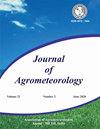半干旱气候下耕作、秸秆、氮素和灌溉管理对冬小麦产量、辐射生产力和水分生产力的交互作用
Q3 Agricultural and Biological Sciences
引用次数: 0
摘要
水、养分和能源是农业生产的三大主要投入,最近由于管理不当和土壤健康恶化,这些投入的要素生产率有所下降。为了在降低自然资源压力的同时最大限度地提高农业生产力,应确定耕作、残留物、氮和水管理的最佳协同组合,以提高小麦的资源利用效率。因此,在一个分因子设计中,试图评估对比耕作、作物残留物覆盖、氮和灌溉相互作用对小麦产量、辐射生产力(RP)和水分生产力(WP)的影响。结果表明,免耕小麦产量(4.8%)高于常规耕作。秸秆覆盖(CRM)和高氮施用提高了小麦的RP、WP和产量;尽管RP随着氮施用量的增加而增加,最高可达100%的推荐氮剂量(RDN)。与除渣处理相比,CRM显著降低了季节性蒸散量(6.0-7.2%)。亏缺灌溉提高了WP,但显著降低了作物产量。因此,在印度半干旱气候条件下,小麦可以在免耕、CRM、100%RDN和亏缺灌溉条件下种植,以获得更高的WP,但在全灌溉条件下可获得更高产量。本文章由计算机程序翻译,如有差异,请以英文原文为准。
Interactive effect of tillage, residue, nitrogen, and irrigation management on yield, radiation productivity and water productivity of winter wheat in semi-arid climate
Water, nutrients, and energy are the three main inputs in agricultural production and recently there has been a drop in the factor productivity of these inputs because of their improper management and deterioration of soil health. To maximize agricultural productivity while lowering strain on natural resources, the best synergistic combinations of tillage, residue, nitrogen, and water management should be identified for improving resource use efficiency of wheat. Hence, an attempt has been made to evaluate the impact of contrasting tillage, crop residue mulch, nitrogen, and irrigation interaction on yield, radiation productivity (RP), and water productivity (WP) of wheat in a split-factorial design. Results showed that wheat yield was higher under no-tillage (4.8%) than that of conventional tillage. Crop residue mulch (CRM) and higher nitrogen application enhanced RP, WP, and yield of wheat; although RP increased with increase in nitrogen application up to 100% recommended dose of nitrogen (RDN). CRM significantly reduced the seasonal evapotranspiration (6.0‒7.2%) as compared to residue removal treatment. Deficit irrigation enhanced the WP while it lowered the crop yield significantly. Therefore, wheat can be grown under no-tillage, CRM, 100% RDN with deficit irrigation to obtain higher WP but with full irrigation to obtain higher yield, and RP in the semiarid climate of India.
求助全文
通过发布文献求助,成功后即可免费获取论文全文。
去求助
来源期刊

Journal of Agrometeorology
农林科学-农艺学
CiteScore
1.40
自引率
0.00%
发文量
95
审稿时长
>12 weeks
期刊介绍:
The Journal of Agrometeorology (ISSN 0972-1665) , is a quarterly publication of Association of Agrometeorologists appearing in March, June, September and December. Since its beginning in 1999 till 2016, it was a half yearly publication appearing in June and December. In addition to regular issues, Association also brings out the special issues of the journal covering selected papers presented in seminar symposia organized by the Association.
 求助内容:
求助内容: 应助结果提醒方式:
应助结果提醒方式:


